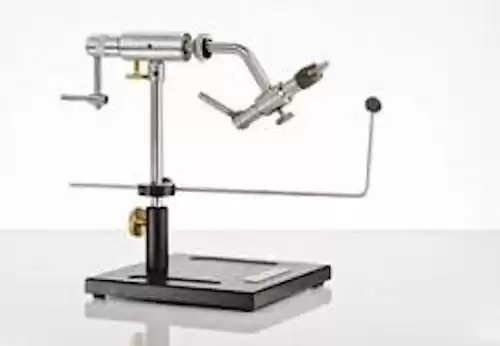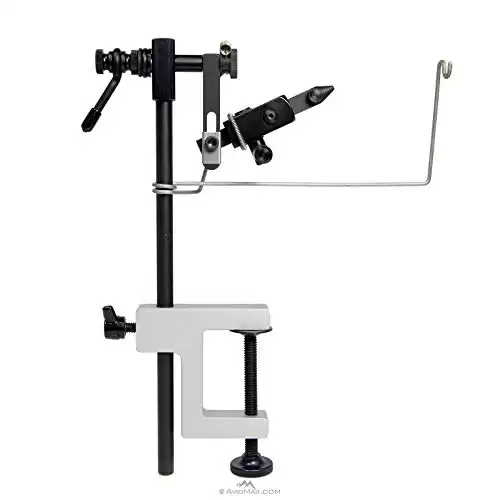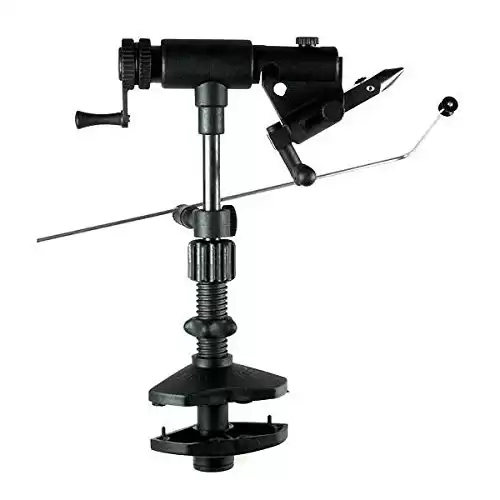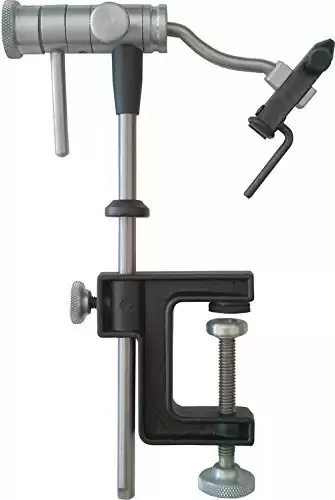A great fly-tying vise is not necessary to great incredible flies but they help tremendously. And a great fly-tying vise does not have to break the bank.
We review the best of the best fly-tying vises below.
|
|
|
|
What is fly tying?
Fly tying is when you attach feathers and fur to a hook with thread to fool a hungry fish when fly fishing.
What is a fly-tying vise?
A fly-tying vise is crucial for fly-tying. The vise’s main job is to hold the hook still when you are attaching the material to it. The types and styles of fly-tying vises vary. We’ll dig into what you want to look for when shopping for a fly-tying vise and discuss our favorites.
Why tie your own flies?
Yes, you can purchase flies online and at a fly shop. However, if you’re like us you are fishing on a budget. Fly tying allows you to have boxes full of flies at a fraction of the cost.
You can spend $20 on hooks and fly-tying material to create 100 flies versus purchasing 5-10 flies for the same $20.
There is also a unique joy that you get by fooling a fish into eating a fly that you tied.
Let’s dig into our favorite fly vises.
Renzetti Traveler 2304 Cam Fly Tying Vise
The Renzetti Traveler vise series may be one of the most popular fly-tying vises out there. The vise series started in 1988. It’s a quality vise that comes on a pedestal. The vise holds hook sizes 28 to 4/0. It includes a 360-degree rotary and a material clip. The material clip is a small addition but makes a big difference when dealing with unwieldy hackles.
Regal Travel Fly Tying Vise
One of the most popular vises out there. It’s unique in its spring-loaded jaws that require no tweaking or adjustment. Simply compress the spring to open the jaws and load a hook. The vise often comes in a pedestal mount and offers a 360-degree rotary.
The Regal Travel vise is limited on its hook capacity at only accepting sizes from 22 to 1/0.
Peak Rotary Fly Tying Vise
A moderate price vise. A great all-around vise and perfect as a starter vise. The vise is versatile. The jaws can hold hooks as large as 2/0 and small as your eyes can see.
It’s a great vise for those of you who fish mountain stream trout in the winter and largemouth bass in the summer. You can recreate all of their food sources with this vise.
It comes mounted as a pedestal but can be removed if you have a clamp mount lying around. I personally prefer a pedestal mount anyways.
Colorado Anglers 2001 EZ Rotary Vise
A good starter fly-tying vise. The vise comes with a C-clamp mount. The vise stand likely will fit in most bases as they are typically the same diameter or you can tighten down the screw to hold it in place.
The hook size the vise accommodates is unknown. A customer shared the tie flies ranging from size 16 to a 2. This is not a huge range but covers most of your needs if you’re a warm water fly fisherman/woman.
The vise does include a 360-degree rotary to make wrapping material quick and easy.
The Colorado Anglers 2001 EZ Rotary Vise lacks many of the bells and whistles of the other vises on this list. But it’s an excellent starter vise and a higher quality than most of the fly-tying kits you’ll find at a Bass Pro Shop.
Dioche Rotary Fly Tying Vise
Dioche Rotary Fly Tying Vise is a good starter vise on a budget similar to the Super AA Chrome vise.
The vise can spin the hook to make wrapping the material easier. It’s not a true 360 rotary as the hook does not stay in line. But for the price it works well.
Dioche claims the fise can hold all hook sizes. This is exciting for the price. It should easily handle hook sizes to support tying your tiny trout flies all the way up to big striper flies.
Maxcatch Rotary Fly Tying Vise Alloy Travel Vise
The Maxcatch Rotary Fly Tying Vise Alloy Travel Vise is great for fly tyers on the road. The price is not bad as well especially as vises get roughed up and occasionally lost while traveling.
I always opt to bring this kind of vise when I’m on the road.
The Maxcatch offers a 360 rotary which is essential when typing a high volume of flies. The jaws are strong and can hold hook sizes ranging from a tiny 28 all the way up to a 1/0.
It’s sold with a clamp which is never my favorite. Especially when traveling as it’s quite difficult to find a table suited for a clamp. Like I mentioned above, the vise can fit in a pedestal base. A pedestal base can be purchased separately (here’s one from Riverruns and one from Griffin)) or built from a block of wood.
Dyna-King Kingfisher Fly Tying Vise
Dyna-King vises are known for their quality and strength. They are some of the tightest and strongest holds in my opinion.
The Dyna-King Kingfisher Fly Tying Vise is no expectation. It’s a beautiful vise without any bells and whistles. The vise is sold with a pedestal base which is my favorite. There is no bobbin holder but there is a hackle spring to hold the material back while tying. It does offer a 360-degree rotary for wrapping material.
Like most Dyna-King’s its jaws can hold hooks ranging in sizes from 22 to 8/0.
Dyna-King Trekker Rotary Vise
The Dyna-King Trekker Rotary Vise is a level above the Dyna-King Kingfisher and Dyna-King Squire. It’s also sold with a pedestal base and supports hook sizes running from a 22 to 8/0.
The vise offers a 360-degree rotary with a handle which makes wrapping hackle even easier. You can spin it with a finger, no griping is required.
Danica Danvise
A short, compact vise. It comes with a clamp mount. The vise offers a 360-rotary and a thread bobbin. The vise accommodates hook sizes 22 to 7/0. It’s a relatively inexpensive vise perfect for new fly tyers. Since the vise is compact, it makes for a great traveling vise as long as you are close to a table. You likely could find a pedestal for the vise to make traveling fly tying easier.
Dyna-King Barracuda Deluxe Fly Tying Vise
Dyna-King makes fantastic vises. They are big, heavy, and feel like a quality vise. The Dyna-King supports hook sizes 8/0 to 22 which makes it a favorite among many saltwater fly fishing guides and tyers. The vise comes with a pedestal or clamp and offers a 360-degree rotation.
Griffin Montana Mongoose Fly Tying Vise
A beefier vise from Griffin when compared to the Odyssey Spider. The Montana Mongoose can hold hook sizes from 4/0 to 28. This vise also feels sturdier and a more quality vise. The vise comes with a pedestal and a clamp. And of course, it offers 360-degree rotation.
Griffin Odyssey Spider Fly Tying Vise
An affordably priced vise. Great for new fly tyers and pros. The Griffin Odyssey Spider holds hook sizes 28 to 4/0. The vise offers a full 360-rotary and a bobbin cradle – perfect for wrapping hackles on a wooly bugger.
It comes in a clamp mount that can attach to most tables and desks. It makes for a great travel vise if you’re near a table or have a separate pedestal mount.
Orvis Ez
A relatively inexpensive vise especially from Orvis. It’s a great starter vise to get a new fly tyers feet wet. It comes with a clamp and pedestal mount. It includes a 360-rotary.
Nor-Vise Fly Tying System
The Nor-Vise is a unique vise. It’s a great vise for tiers that spin hackle and chenille constantly. It has its own learning curve as it’s not the normal rotary functionality. The Nor-Vise comes with its own bobbin that compliments the Nor-Vise spinning functionality.
It’s a fun vise to tie flies with. It’s a great vise for commercial tiers and those that tie the same flies repeatedly. The vise offers a 360-degree rotary, mount, bobbin holder, and special bobbin.
Stonfo Transformer
Stonfo is a fishing manufacturer based in Italy. As with many Italian goods, quality is important. The Stonfo Transformer is no different. The Stonfo Transformer comes with a pedestal and 360-degree rotation.
This vise also includes a 45-degree locking shaft that allows tiers to adjust the shaft angle for a tighter 360-degree rotation in reaction to hook sizes.
Super AA Chrome Fly Tying Vise
The Super AA Chrome Fly Tying Vise is a decent starter vise. The vise is inexpensive and a great starter vise. It’s worth the price. And while you can find a vise of relative price range at a thrift store, you’ll sacrifice wear and tear. You can guarantee the Super AA Chrome Fly Tying Vise is brand new out of the box.
While I do not like clamp vises, you likely can mount this vise in a pedestal base (check out this one from Riverruns and this one from Griffin). Or even build your own using a block of wood.
The vise also has a 360-degree rotary to make wrapping material a breeze. The vise lacks a bobbin holder and material clamp. This is not a big deal with the price out the door.
The vise’s jaws are impressively adaptable. They can hold a hook ranging from a tiny size 20 all the way up to a 3/0.
Wolff Industries Apex
The Apex by Wolff Industries comes with a pedestal and clamp mount. The vise holds hooks ranging in sizes from 7/0 to 32.
The Apex also has a 360-degree rotation on a straight arm for an in-line rotary.
The vise is smaller which makes it perfect for travel, especially with the varying forms of attachment (pedestal vs clamp).
Atlas Fly Tying Vise
#Best Fly Tying Vise Under $200
A sturdy vise that comes with a pedestal and clamp. It’s right in the middle as far as pricing in the fly-tying vise market. It offers a 360-degree rotary and accommodates hook sizes 7/0 to 32.
Byron Rotary Fly Tying Vise
The Byron Rotary fly tying vise includes the essentials any novice or expert fly tyer needs. The full 360-degree rotary paired with a bobbin holder and material clip make wrapping hackle and chenille a breeze.
The Byron vise accommodates hooks from a tiny size 28 all the way up to a jumbo 4/0. It’s a must-have for the fly fisherman/woman who matches the hatch for trout and chucks baitfish patterns to busting stripers.
The Bryon team also includes a custom travel case to make transporting the vise a breeze. And the pedestal base allows you to tie anywhere, no clamp is needed. Definitely my preferred way of tying.
Best Rotary Fly-Tying Vises
A rotary fly-tying vise makes wrapping material on the hook a breeze. While it’s not required, it does save your wrist some movements which adds up over time. I’ll never go back to a non-rotary vise after using mine for more than 10 years.
|
|
|
|
Fly Tying on a Budget
We don’t believe fly-tying needs to break the bank. You do not need a top-of-the-line fly-tying vise to tie a fly that catches fish. It’s best to start with something you can easily afford. So we’ve collected the best fly-tying vises.
|
|
|
|
Frequently Asked Questions
What are the best fly-tying vises?
There are many fly-tying vises on the market. The best fly-tying vise depends on the beholder and their values. It’s not always the most expensive.
One of our favorite vises is the Regal vise because it’s fast. You can swap out hooks in miro-seconds. It’s a great starter vise if you are willing to spend the money.
What should I look for in a fly-tying vise?
A true rotary fly-tying vise is a must. It greatly simplifies your fly-tying effort especially once you get the hang of it.
You need to make a decision whether you need the fly-tying vise to come with a mount or if you can attach it to the side of a table. Many vises can use any stand but not always.
Not every vise can accommodate all hook sizes. Think about which fish and how big their food is before you purchase a fly-tying vise.
What is a true rotary fly-tying vise?
A true rotary fly-tying vise allows the fly-tying jaw where the hook is clamped to rotate a full 360-degrees. And the hook will remain on the same flat horizontal axis making wrapping material on the hook a breeze. True rotary fly-tying vises include an arm to make spinning the vise a breeze.
What’s the easiest fly to tie?
The easiest fly patterns to tie require the least amount of fly-tying material and can be tied within minutes.
Based on our experience, the easiest fly to tie is greenie weenies (inchworms), Zebra nymphs, and black foam beetles.
Wrapping It Up
Fly tying is a huge money saver. It’s hard to express how much fun it is to catch a fish on a fly pattern you tied. The feathers you tied on a hook fooled a fish into thinking it’s alive and is food.
You don’t have to buy everything at once. Start slow with a vise, black thread, and an easy pattern like a wooly bugger. As you learn more techniques, purchase more specialized materials.
Did we miss a fly-tying vise? Let us know which one and why we should include it on our list here.
























